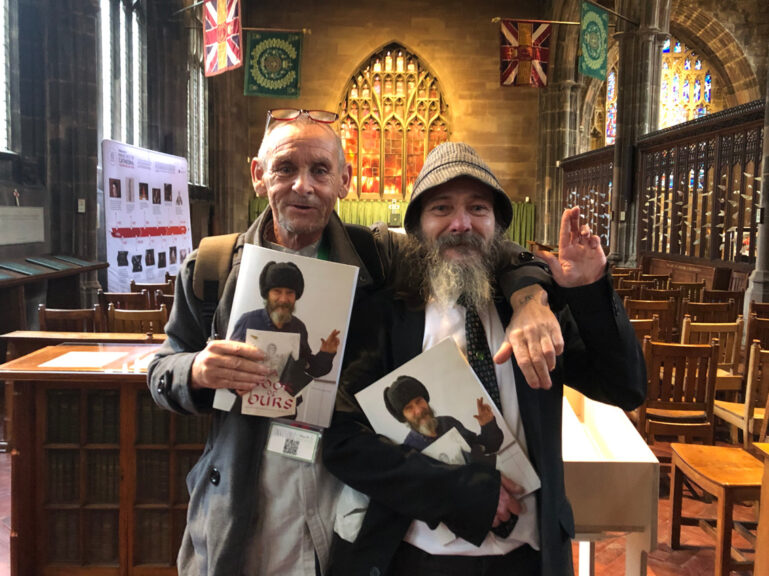The lives of homeless people in Manchester have been illuminated with the publication of a medieval style manuscript launched at Manchester Cathedral yesterday. Made by over 100 people, the Book of Ours records their stories in writing through medieval-style drawings and calligraphed poems and songs.
The Book of Ours project ran over two years, was directed by “arthur + martha”, an artist Community Interest Company (CIC) run by Lois Blackburn and Philip Davenport.
Created during weekly sessions at the Booth Centre with support from the charity Back on Track and funding from National Lottery Heritage Fund, the book produced in the style of a medieval illuminated manuscript aimed to make “homeless’ ignored experiences heard”, Davenport said and added:
“We’re going to make people heard and they are going to be treated with power, with respect and they’re going to be decorated with gold and have hundreds of hours dedicated into making this testimony of many voices.”

Lawrence McGill, originally from Glasgow, with lived experience of homelessness said:
“To start with, it was a place to go where I wouldn’t drink or take drugs until later on in the day. Maybe learn something, and I learnt lots and lots. I learned that I can write, that I can write interesting stuff other people might actually be interested in.”
A former labourer whose hand was damaged by machine vibration, McGill described how during sessions ran by people “who are the best doing what they do” he found his voice:
“There’s a man who taught me calligraphy and any time I meet him I say “this man taught me how to write” and they would say “didn’t you write at school?”. But he taught me how to really write.”
“The only reason I go to Booth Centre anymore as I’m housed now and reasonably happy, is for these people because the education they have given me is unbelievable,” he said.
At the launch, the makers of the manuscript performed poems and songs in variety of different styles, including McGill’s performance of his poem Spinning Plates, of which he said:
“The best thing I’ve ever done is the Spinning Plates, which could also be a song. I should release it as a single for the homeless, to support the homeless.”
Davenport explained how the combination of words and visuals helped those with literacy difficulties: “Also, people can feel self-conscious, especially if they have difficult stories to tell. Visuality can open all of that up. And the culmination of the two things gives people many routes into telling a story.”

Gary Cundle from Salford, and formerly homeless for two years, arrived with his step-son to see the manuscript featuring a diary entry in calligraphy inside gold and fine pen-point details created by him.
A small and hardly visible but almost smiling saint- like figure in the top corner over the title “August” was a self-portrait: “I’m glad you clocked it”, he laughed.
“Creativity is something to focus on. It’s a meaning instead of doing nothing. And people are now looking at the manuscript and we can say ‘we have done that’. Like my diary piece, these kinds of diaries have gone on for thousands of years and so will this and people will know who made it,” Cundle said.
Like its Christian theology inspired medieval illuminated predecessor scripts, this modern day manuscript made in Manchester is divided into sections such as Suffragges, Office of the Dead and The Joys.
Alongside the stories of hope, healing and joy in the Book of Ours are also those of death, loss and struggle:
“People will know who made it”

The first will be last/ Last will be firstWhatever is mine/ It’s probably worse
Exodus, by unnamed writers
Co-director of the project Lois Blackburn said:
“These are stories that are written by people who are in very vulnerable situations at that time but they are stories that could be written by any of us… The themes bind us all together as it is about human experience, from birth to death.”
The one-of-a-kind manuscript made over two years stays on show at the Manchester Cathedral in the city centre for the next six months.
After this, it will be permanently housed at the John Rylands Library at the University of Manchester, where it was initially constructed by conservator and binder Mark Furness, using historical tools.
The Meteor is a media co-operative on a mission to democratise the media in Manchester. To find out more – click here
Sign up to The Meteor mailing list – click here.
Featured image: Noora Mykkanen


Leave a Reply